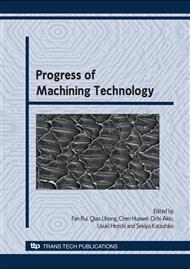p.432
p.436
p.440
p.444
p.448
p.452
p.456
p.460
p.465
Cutting Parameters Optimization of Thin-Walled Workpiece Based on Deflection Control
Abstract:
Thin-walled workpiece is prone to produce deformation in the process of machining because of cutting and clamping forces. In this paper, a model of cutting parameters optimization is proposed to control the deflection. The influence of deflection on nominal milling depth is taken into account and the machining deflection is computed by iterative method. Based on the optimization model, a prototype system is developed to optimize the cutting parameters for a thin-walled workpiece with the genetic algorithm and finite element method. Finally, a simulation example is used to demonstrate the feasibility of the cutting parameters optimization method. The simulation result can be further employed into practical machining situation.
Info:
Periodical:
Pages:
448-451
Citation:
Online since:
February 2009
Authors:
Price:
Сopyright:
© 2009 Trans Tech Publications Ltd. All Rights Reserved
Share:
Citation:


